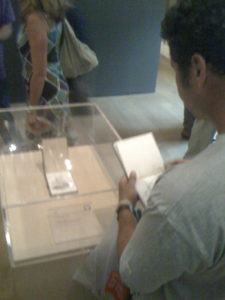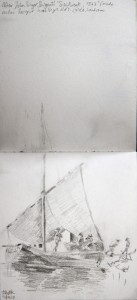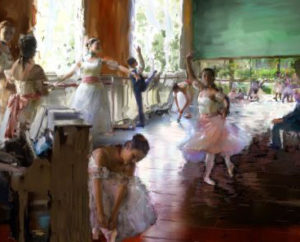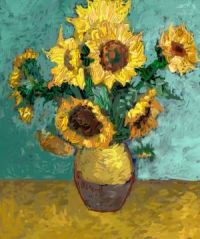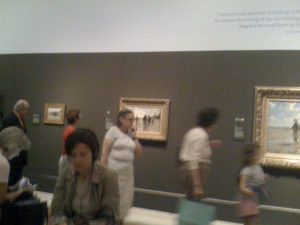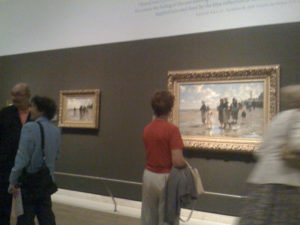On July 14th, 2010, I walked into the historic Royal Academy of Arts in the center of London to see an art exhibition “Sargent and the Sea”, now showing at the Corcoran Gallery in Washington D.C. until January 3rd, 2011. Read the Independent, Guardian and Telegraph newspaper reviews of the London show.
I was already familiar with the magnificent society portraits that Sargent is so well known for and loved the loose expressive brushwork of his Italian watercolors, sketches and oils. His seascapes were new territory to me. I associated nineteenth century plein air seascapes with the likes of Claude Monet and his portrayals of the beaches of Normandy. Monet’s depiction of the sunrise at Le Havre harbor gave rise to the term impressionism. The two other names that came to mind when I thought of seascapes were J. M. W. Turner‘s stormy sea abstractions and Joaquin Sorolla’s glorious warm late-afternoon Valencia beach scenes.
Thus I was curious what I would find of Sargent’s interpretations of the sea. The exhibit started with his early drawings and I was taken with one, a beautiful small drawing in a sketchbook of a sailboat dated 1872, when Sargent was just sixteen years old. I got out my own sketchbook and started sketching a copy of it at almost the same scale. As I worked through the tones, sought to capture both the strong contrasts and subtle nuances, I came to a greater appreciation of his skill as a consummate draughtsman.
I find that I learn a lot through repetition—through either copying a great masters work, or through creating a fresh original work based on the artistic and compositional style of an artist. In the last two months this has proven true with two assignments I have had, the first to perform as Edgar Degas (see Dance Rehearsal)
and the second to perform as Vincent van Gogh (see Sunflowers), both at the de Young Museum which is currently hosting the Van Gogh, Gauguin, Cezanne and beyond: Post-Impressionist Masterpieces from the Musée d’Orsay).
As I walked deeper into Sargent and the Sea, swimming through turbulent waves, past tilting ships I came to a very interesting sight: that of a S, M and L repetition. Yes, that’s right, just like a t-shirt shop: small, medium and large. Only the repetition was of a beautiful oil painted scene, En Route pour la pêche (Setting Out to Fish), 1878, reproduced by Sargent himself in three different sizes. Seeing the three identical but different sized paintings next to each other in one room really struck me. It was simultaneously odd, impressive and comforting.
Odd because it begs the question as to Sargent’s motivation. Was he dissatisfied with the earlier ones? Were the smaller ones studies for the larger one (they didn’t look like studies since they were equally detailed)? Was it business reasons—did he have three different clients who liked the painting but wanted them at three different sizes?
Impressive since the three were remarkably alike. That alone must have taken a great deal of skill and time to achieve, well before the advent of giclees! And comforting since it went to the heart of an issue that comes up in my life as a professional artist using a combination of digital and traditional media. That issue is the devaluing of a painting due to the perception that digital means potentially reproduceable and therefore not guaranteed unique.
Clearly, from Sargent’s in-your-face example of multiple originals, that issue is not a digital issue. Ultimately, no matter what the medium, a collector has to have a certain understanding and trust with the artist regarding the uniqueness, or otherwise, of the work.

Jeremy Sutton, artist, author and educator, was born in London and studied drawing, sculpture and print-making at the Ruskin School of Drawing and Fine Art at Oxford University while earning an MA (Oxon) degree in Physics. He then studied lithography and drawing at the Vrije Academie in The Hague, The Netherlands. Now based in San Francisco, Sutton is an internationally recognized authority and pioneer in the field of digital painting, a Corel Painter Master and a featured platform presenter at major international conferences, including Siggraph, Macworld and Imaging USA. He is the author of twelve books, instructional videos and DVDs.
Jeremy founded the art training web site PaintboxJ.com, and runs workshops in his San Francisco studios and around the world. Subjects who have sat for portraits by Sutton include former San Francisco Mayor Willie L. Brown, Jr., British entrepreneur Sir Richard Branson and baseball legend Willie H. Mays. Works by Sutton are currently in the traveling Nina Simone Experience exhibition.

